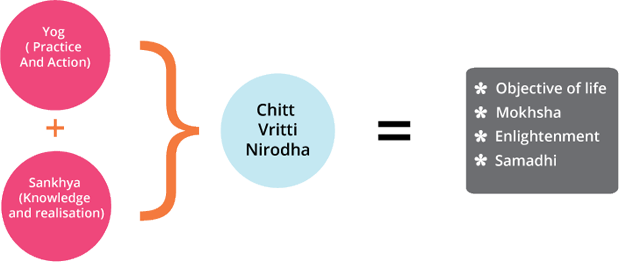Our basic objective is to promote understanding of Sankhya (also written as Samkhya) system, which is the oldest Darshan (Philosophy), is accepted as the oldest philosophical system in the whole world. Sankhya system have provided theoretical base to many of the Indian spiritual pathways including Yoga, which is a structured and practical way of achieving spiritual truths envisaged in Samkhya.This Philosophy has influenced almost all eastern philosophical schools including Jainism and Buddhism. In recent past different forms (names) of Yoga e.g. Bhakti yoga, Karma Yoga, Hatha Yoga, Kundalini Yoga , Dhyan Yoga etc. etc. have emerged worldwide, but underlying thread of belief (Samkhya system) at the core of all these different Yoga ‘forms’ remains same. In this context a clearer understanding of the concepts prescribed in Sankhya theory therefore is of great benefits to adherents of any of the so called yogic system. Traditionally in India, Sankhya and Yoga are considered complimentary to each other and it is believed that there is no knowledge is as valid as ‘Sankhya’ and there is no action as sacred as ‘Yoga’. Often these both philosophical systems are together referred as ‘Sankhya-Yog’. The most sacred text of Hinduism ‘Bhagavadgita’ stands as a foremost testimony to the importance of ‘Samkhya’ philosophy in ancient India. The title of the most important chapter (The second chapter) of Shri Bhagavadgita, is,“Sankhya Yog” and unless this Sankhya philosophy had a widespread recognition and acceptance as a very predominant philosophy in ancient India, this chapter would have not been given this unique title.
Following statements from ancient Indian scriptures indicate the importance of ‘Sankhya-Yog’ in spirituality.
- There is no wisdom like ‘Samkhya’, no power like ‘Yoga’ – Mahabharata
- The root cause (Brahman) is to be apprehended by ‘Samkhya-yog’ – Svetasvatara Upanisad (6.13)
- There are two paths available in this world for the seekers of ultimate truth – Yoga of knowledge as followed by the Samkhya Yogis and Yoga of action as practiced by the Karma Yogis – Lord Krishna ,BhagwatGita (3.3)
- Only the ignorant one’s differentiate between ‘Samkhya’ and ‘Yoga’; not the wise one’s, One who considers both as ‘integrated’ has the right insight – Lord Krishna ,BhagwatGita (5.4)
A good understanding of ‘Samkhya-yog’ theory brings a positive discrimination to our mind that enables us to differentiate ourselves as something beyond a Physical body living in this materialistic world. Once this discrimination is acquired and believed only then one can climb ladders of spiritual world. Without an understanding of Samkhya Philosophy, Yoga becomes simply a physical exercise, which is more or less the current situation in the modern world. This entire process of understanding self and achieving the discrimination of being separate from material world (nature) thus can be termed as ‘Samkhya-yog’. This knowledge brings a good insight into ‘nature’ of self and helps in finding right ways of deep meditation.

